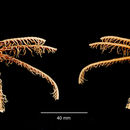en
names in breadcrumbs


This species is recorded from the Gulf of Mexico, throughout Caribbean Sea to Brazilin the South Atlantic Ocean.
This species is recorded off the Caribbean coast of Panama from:
- East of Mosquito Point (USNM E 25913), Centroid Latitude: 9.0417, Centroid Longitude: -77.5633, depth 280 to 300 m
- Galeta Point, Galeta Island (USNM E 18790) Centroid Latitude: 9.4 , Centroid Longitude:-79.87, depth 6 m
- 5 miles northeast of Pina (USNM E 25882), Centroid Latitude: 9.3417, Centroid Longitude: -80.2250,
- San Blas Point (USNM E 25863), Centroid Latitude: 9.5633, Centroid Longitude: -78.6033, depth 70 to 73 m
Agassiz, L. in Agassiz E. C. & Agassiz, L. (1865). Sea-side Studies in Natural History. Marine Animals of Massachusetts Bay. Radiates. Ticknor and Fields, Boston.
Messing, C. G. (1978). A revision of the comatulid genus Comactinia A.H. Clark (Crinoidea: Echinodermata).-Bulletin of Marine Science 28(1): 49-80.
World Register of Marine Species
LSID urn:lsid:marinespecies.org:taxname:246741